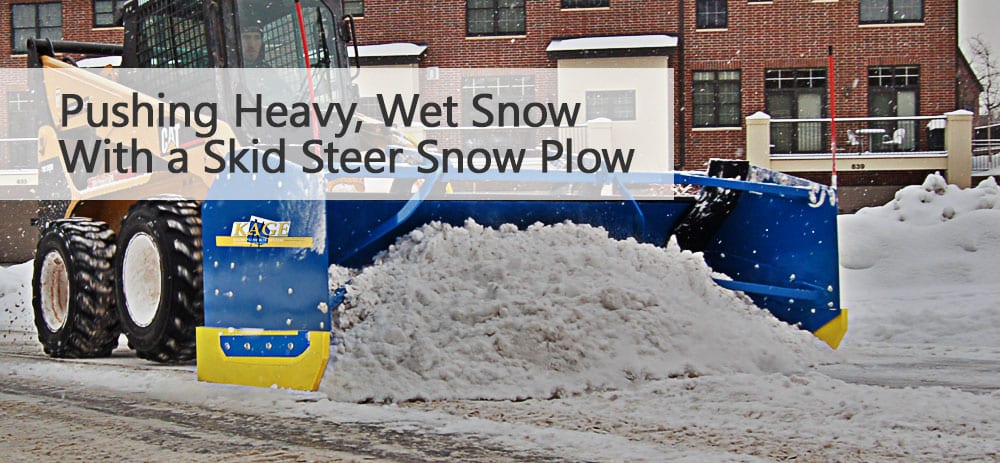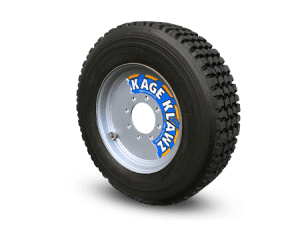
“Just curious what the best way to plow heavy wet snow? Seems like this stuff don’t want to push easy, for any distance. I have to keep stopping backing up and ramming through 1/2 the pile in front of the blade, then going back over what was left.” – 2dogs2/Member on Plowsite
I was reading through forum posts on topics to write about and plowing heavy, wet snow seemed to stick out since we’re moving toward the last few months of the winter season. Even though the forum post I pulled that quote above from was mostly about trucks, I felt many of the points being brought up could also pertain to skid steer snow plow operators.
Throughout the winter, as big storms hit, we’re all a little more frantic to stay ahead of the falling snow, but when it’s really heavy snow that’s falling, trying to take it head on could lead to a less efficient use of your skid steer snow plow and/or pusher.
Ramming” the Snow Piles
My motto is if the coffee splashes it’s okay, but if the cup flies out of the holder to the floor you’re pushing too hard!” – SteveJ/Member on Plowsite
It’s safe to say, hogging that pile of snow you back dragged into the street from a driveway is not going to be all that easy to take on in one shot if it’s the heavy stuff. The common rookie solution to moving this pile is to just come at it faster and ram it towards its final resting place.
Come at the piles of snow taking away smaller, more manageable loads. Remember, it’s not just about moving the snow, but stacking it up as well. Take half a box load with your KAGE Snow Plow System and get it moved quickly and easily.
Another possible outcome from “ramming” the snow piles is damaged equipment. You could shear bolts, crack welds or bend various parts. Repeated pounding can do damage to your machine, your plow and in some cases … you. Work on the side of efficiency by taking on what you know your skid steer can handle.
Snow Tires, Snow Tires, Snow Tires
 Guys and girls, we can beat the topic of traction into the ground, but honestly, if you really want to get the job done fast, you’re going to need it. And yes, I’m going to say it, KAGE Klawz are the best darn skid steer snow tire on the market today. ($1,400 for a set of 4 snow tires with wheels, nuff said)
Guys and girls, we can beat the topic of traction into the ground, but honestly, if you really want to get the job done fast, you’re going to need it. And yes, I’m going to say it, KAGE Klawz are the best darn skid steer snow tire on the market today. ($1,400 for a set of 4 snow tires with wheels, nuff said)
Okay, done pitching the product. Now let’s talk tires. Your dirt tires were probably did just fine during the early days of the snow season. Couple inches here and there, those old dirt tires are “good enough”, right? Well let’s see how you like those old dirt tires when the snow’s wet and greasy. Your traction is lost and your job just got ten times harder.
Angle Plowing and Pushing Heavy Snow
Wherever possible, angle plow the snow into smaller windrows if angle plowing is necessary. Come back with your pusher box attached to move to the final dump site. Again, taking on too much heavy snow in one pass is not going to get you home any faster.
If you need to push the snow straight on toward the dumping site and know you can’t push the entire length of the lot, start pushing the half of the lot that is closest to the dumping site then come back around for the other half. This will alleviate having to take it all on in one push. It may seem like you’re losing time, but it won’t be as difficult to handle.
Have a Plan and Watch Weather Reports
Again, these all might seem like “no-brainer” tips, but inexperienced operators can easily find themselves being bogged down with heavy wet, snow in a big lot. For snow removal business owners, have a plan for these types of heavy, wet snow storm events and communicate that with your snow removal operators ahead of the storm.
Typically, if you’re closely watching the weather report, and more specifically, the temperatures at the time of the snow falling, you should be able to determine if the snow will be heavy or not.
KANON KULPA
Marketing Manager

Recent Comments